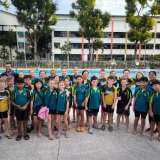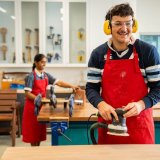Must Do Toddler Activities To Encourage Physical Development
Young children have boundless energy. Just watching them run around can be positively exhausting! But when it comes to playtime, more and more toddlers and preschoolers are also spending time with electronic devices, such as tablets and phones.
Many of these have educational applications, which can be valuable for early learning. However, increased screen time favors periods of stasis at the expense of play, which obviously involves healthy physical activity. With this in mind, it is important to do as much as possible to encourage your child’s physical as well as mental and emotional development.
Understanding the importance of your child’s physical daily diet
Your child’s natural development requires repeated movements of muscle groups. These movements contribute to their motor skills — both gross (large) and fine (small). The large motor skills develop first, so you should see children aged two, three and four doing lots of running, reaching, and jumping. Indeed, we don’t often see them sitting still for very long! The small motor skills require dexterity that develops later when kids learn to use their hands for fine movements, such as drawing or playing with smaller toys.
Both types of motor skills are important during any child’s development and growth, and activities for both should be encouraged. At the Australian International School (AIS) in Singapore, the younger children from families living in the city are able to take advantage of lots of different outdoor pursuits provided in the uniquely designed AIS Early Learning Village.
The Village’s three outdoor playgrounds, encouraging children to clamber over climbing frames, jump through hoops and kick footballs into soccer nets to help develop their coordination skills. They can also enjoy bike rides on the outdoor track, which improves their coordination and balance skills.
Simple activities you can try outdoors
A family walk is a great way to make sure everyone gets a good dose of fresh air and an opportunity for exercise. Encourage your kids to partake in alternate periods of walking, jogging, marching and running. In quieter moments, encourage them to start a collection of pebbles, leaves or shells, depending on where you are walking.
If the weather is pleasant and you have a sandbox, introduce lots of small toys the kids can manipulate, and add different sized plastic cups for pouring and building games.
Your condo pool or garden can also be used for water play. Running around and splashing is great fun — just make sure there is adult supervision when your children are playing with water.
Ball games that involve catching, rolling, throwing or kicking are great for building those important muscle groups, and the more your children practice the more skillful they will become. Keep the rules simple for toddlers and preschoolers. For older kids, a basketball net offers an incentive to stretch and reach, as well as an opportunity to develop hand-eye coordination.
Indoors or out, young children love animal games. Besides making the appropriate noises, encourage them to pretend to be a puppy or kitten, walk like a chicken or gallop like a pony. Other options include playing wheelbarrows, rowing a boat or flying like an aeroplane.
Things to do indoors
An indoor alternative to the family walk is a parade around your home using real or imaginary musical instruments, flags, balloons or whatever else is available. You could also make an obstacle course, using cardboard boxes and scattering cushions or any larger toys that are safe for your children to climb on.
Did you know that playing musical instruments boosts your child’s physical development in tandem with the associated mental benefits? This means that not only is their dexterity improved, it can also enhance their concentration and confidence. So if your toddler or preschooler wants to flex their fingers, wrists, arms, elbows, and shoulders by bashing a keyboard, try to put up with the noise and let them play. You can always follow up with some quiet time activities while your ears recover!
Some tunes are ideal for encouraging movement. Let your kids sing along to nursery favorites such as The Wheels on the Bus and I’m a Little Teapot and check with teachers to see if there are any familiar classroom songs you can repeat at home. Consider teaching your toddler games with vocal aspects that also encourage small motor skills, such as Itsy Bitsy Spider and Patty Cake.
There are a lot of different activities you can do at home to encourage your young child to move. Just remember that all the time you’re playing together, you’re helping to balance your child’s daily physical diet!






